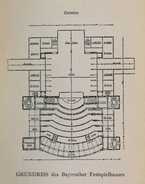EN | CS | HU
history of the theatresupplementtechnical dataHistoric equipmentFestspielhaus
Otto Brückwald
Festspielhügel 1, | |
| show on the map | http://www.bayreuther-festspiele.de/english/english_156.html |
Important events
(detail)1962 | reconstruction
reconstruction 1962-1973: Lothar Linder
Seating capacity since 1973 = 1925
People
Otto Brückwald |main architect
Lothar Linder |architect
Eberhart Pöhner |architect
H.C. Reissinger |architect
Franz Rank |architect
Gottfried Semper |architect
History
Additional information
No information has yet been entered
Add information


























